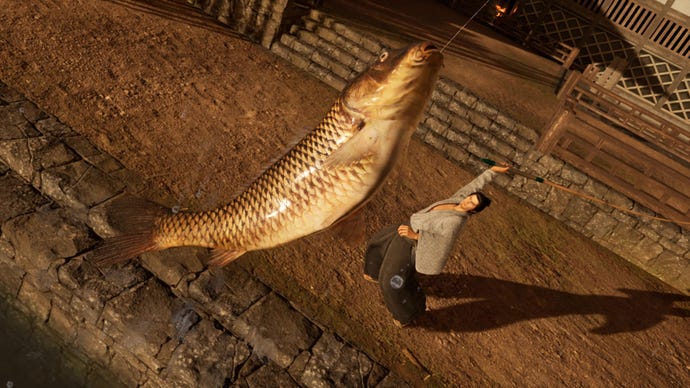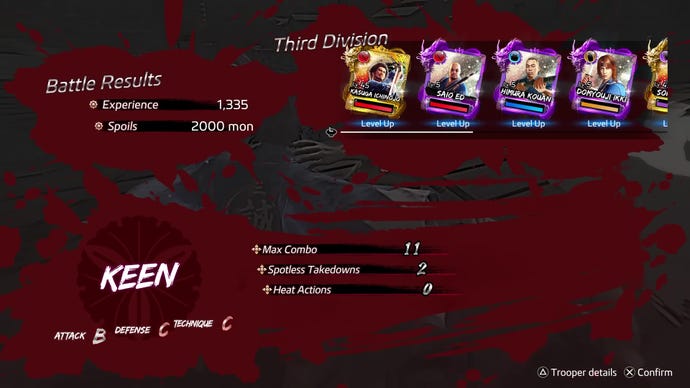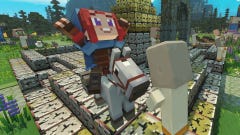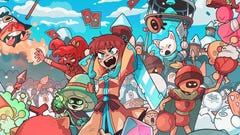Like A Dragon Ishin review: a step backwards in the best way
That's radish
I am legendary ronin Sakomoto Ryoma. I shout "yosh!" as I harvest six (6) gleaming radishes from my allotment. I shoot a bandit in the head with a revolver. I send my adoptive daughter to trade some homemade pickles. I partake in a brooding chat, then stamp on a dude's head. I help a recluse regain his confidence. I have totally forgotten what I was meant to be doing.
Like A Dragon: Ishin feels like a step backward, but in a brilliant way. Kiryu and co. may have moved onto a turn-based future, yet Sakomoto Ryoma and his pals have turned back the clock to an Edo period of brawlin' and chicken betting that's most reminiscent of Yakuza 0, only it's not the roaring 80s but the bloody 1800s. There's nothing here that will convert those who aren't keen on the series, but if you're an ardent fan or a newcomer eager to experience its wild swings between serious and silly, Ishin is an excellent place to start.
Like A Dragon: Ishin was originally a Japan-only Yakuza spin-off that released back in 2014 and never came to the West. Now a few years later, we've got an entirely remade Ishin which means everyone can experience the joys of late Edo period faction warfare. I'd liken the game to a one-off Yakuza special set in 1800s Japan, where many of the series' favourite characters take on entirely different roles. Kiryu is Sakamoto Ryoma, a real historical samurai who’s still basically Kiryu in personality. Others, though? Damn, who knew they could be so nasty? If the Super Smash Bros announcer were to describe the roster in a shout, he'd say, "ALMOST EVERYONE IS HERE!!".
Don’t let lots of returning characters put you off, though. The game will delight longtime fans like me, but it’s also built with total newcomers in mind. You aren’t missing out on anything if you’ve never played a Yakuza game before, as the story is a self-contained murder mystery wrapped up in a battle between two factions: rebels who want Japan to drop a restrictive class-based society, and the shogunate who’d quite like to keep it going. It’s immediately compelling stuff as you go undercover with the bloodthirsty shogunate to find out who out of their murderous bunch killed your dad. Enemies become friends. Friends become enemies. It’s compelling stuff, helped by a samurai setting that perfectly intertwines with Yakuza's drama.

Over the years we've been treated to the colourful crash of Kamurocho and Dotonbori, or the expansive port city of Yokohama. Sapporo and Nagoya have featured, too; all hustle and bustle. Truthfully, it's Yakuza 6's seaside city of Onomichi which sticks out in my mind as the loveliest spot, with bustle balanced by plentiful leaf rustle. As much as I like cracking thug pelvis between skyscrapers, or slurping ramen under dangling electrical wires in a dingy back alley, the quaint side streets of Onomichi really do it for me. Ishin's city of Kyo certainly ranks up there with it as one of my all-time faves, namely because it's an equally warm place to be.
Kyo really is transportative. Palanquin fellas trot down dusty streets and merchants bark from stalls, and crucially, it all feels faithful. You get a storyteller who shifts across the city, enchanting passersby with tales from far-flung places like Nagoya - you wouldn't believe the things he's seen! At night, lanterns bathe markets in an orange glow, and if you stop by an izakaya, its menus provide detailed descriptions of eel dishes and old-school delicacies.




And if you need to get away from the seriousness of the story, Kyo offers plenty of pastimes to lose hours to. You can belt out some bangers in the singing parlour and slice cannon balls in half. There's even the option to play rock paper scissors in a brothel, or like, open your own ramen stand. I can't tell you how much time I've spent plucking broad beans from my little allotment and betting on chickens. I've been to a lot of Yakuza's Buffets Of Distraction, and let me tell you, Ishin has put on a good spread.
Out of all the Yakuza games, I'd say Ishin features some of the best brawling of them all too, and that’s thanks to Ryoma's ability to switch between four different fighting styles: Swordsman, Brawler, Gunman, and Wild Dancer. Other games in the series also feature swappable styles, sure, but here you're freed from the confines of calcium and let loose with metal delights, like revolvers, katanas, and even a combination of revolver and katana.

One unexpected downside to the other styles being so much fun, though, is that the Brawler's fisticuffy fighting style is dulled by the others and their fluidity. Its stiff kicks and punches simply can't compete with the Wild Dancer's ability to turn into a deathly spinning-top, or the Swordsman's elegant cleaves. Swinging knuckles is a lesser alternative to, say, peppering a loyalist from afar with flammable slug rounds, then turning him into a bloodied Chupa Chup as you prod a blade through his ribs.
Choice is Ishin's strength, as even if Brawlers feels a bit redundant, the game does seem to encourage switching things up if you're taking on powerful foes. Acidic rounds can pierce armour far better than a blade can, for instance, while Wild Dancer's evasive prowess is often a must for the spriteliest of bastards. It might be fairly simplistic stuff by today's RPG standards, but it makes a nice change for Yakuza, where – aside from Yakuza: Like A Dragon's turn-based battles – style swaps haven't been all that essential.
But I wouldn't say Ishin resolves all of Yakuza's historical woes when it comes to combat. Street thugs morph from funny larks into irritating pests you'd rather swat away in an instant. And – at least early on - you're forced to open the inventory menu every time you'd like to heal sizeable chunks in a pinch, which adds major clunk to the most climactic of tussles. Some things are hard to shake.

The game also handles the RPG side of things in a typical Yakuza manner: you must become an exotic goods warehouse. Question) You want a thing?; Answer) You cannot have it, unless you have a thing to give. To craft, say, "Your Dad's Sword" at the blacksmith (hypothetically speaking, of course), you must have lots of money and like, two pieces of golden manure, some manuka honey, and "The Blade Of Papa" to hand. To get these, you must spend time in tucking into the larger portions of the Buffet, accepting missions at the trooper camp, which involves clearing waves of enemies from caves and smashing boxes of loot.
Being shuttled into Ishin's heftier minigames isn't all that bad, though, because they're simple and direct. Yes, you may have to pour time into another activity to get some golden manure, but at least the activity is self-contained in a wacky scientist's clockwork scarecrow house, or a calming villa out in the sticks where I get to harvest radishes and flip my little salmon so it chars nicely on the firey wirey. Technically you don't need to bother with any of these side hustles, but trust me, it's impossible not to get sucked into dungeoneering or a bit of peaceful farming.
Yakuza's substories (side quests) are legendary, not only for their humour and surprising depth, but also for reflecting each game's setting in the silliest of ways. Ishin provides some of the series' finest examples yet when it comes to supplementing its murder-mystery melodrama with stories rooted in 1800s Japan. One example being a run-in with a teacher who drags you into a geography lesson of his, all because he's embarrassed that he can't pinpoint any of the countries on a globe he's been gifted by a pupil's parents. Another time you help a “Heyazumi” (literally, a person living in a room) redeem himself in front of his mother.
Here's me chasing down a fella who stole my clothes while I relaxed in a bath house. This gif deserves an installation at the Louvre, I'd say.
I will say that Ishin's perhaps a bit too keen on you forming bonds with certain folks. There's a lot of "friendship meters" that you're meant to oh-so gradually fill as you repeatedly interact with shopkeepers or sword enthusiasts or some kid who absolutely loves vegetables. I get that it's not a massive deal! In fact, it's nice handing "Kid Who Loves Veggies" a treat from your farm each time you pass him on the way to a mission. And I get that longtail payoff is an enticing thing, but sticking bars above heads has never felt particularly in keeping with Yakuza's concise, human storytelling.
So yes, Like A Dragon Ishin isn't going to convert those who dislike Yakuza. It still carries some of the series' historic frustrations and feels like a bit of a step backward when you compare it to Yakuza: Like A Dragon's turn-based shake-ups and modernisations. Although, a step backward isn't a bad thing at all! Ishin feels most like Yakuza 0 (my fave) that's sure to please longtime fans, and its standalone nature means that it is, without a doubt, one of the strongest starting points for newcomers. Now excuse me, I best get back to harvest my radishes.


















